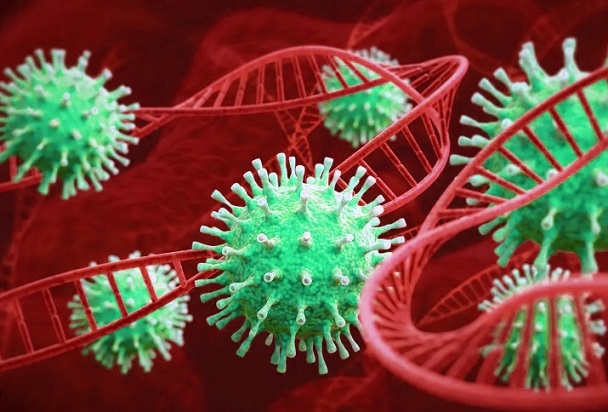U.S. Study Uncovers Hidden Danger in SARS-CoV-2 Mutation Patterns
Nikhil Prasad Fact checked by:Thailand Medical News Team Apr 21, 2025 2 hours, 46 minutes ago
Medical News: In a groundbreaking study conducted by scientists from Indiana University School of Medicine and Johns Hopkins University School of Medicine, a new mutational pattern in the SARS-CoV-2 virus has been identified that may explain the variation in COVID-19 severity across different patient groups. This
Medical News report explores how a specific mutation type known as G-to-U substitution is becoming more common in key functional regions of the virus and how this may influence disease progression and immune response.
 U.S. Study Uncovers Hidden Danger in SARS-CoV-2 Mutation Patterns
U.S. Study Uncovers Hidden Danger in SARS-CoV-2 Mutation Patterns
The collaborative research was led by Xierzhatijiang Sulaiman, Jun Wan, and Jikui Shen with contributions from Yan Han, Sheng Liu, Kailing Li, Marissa Shang, Lei Yang, Kenneth White, and Yong Zang. The scientists analyzed over 5.9 million complete SARS-CoV-2 genome sequences sourced from the GISAID database to better understand the virus's evolution.
C to U Still Dominates but G to U Mutations Gaining Ground in Dangerous Ways
It has long been known that the C-to-U mutation (caused by the host enzyme APOBEC) is the most common mutation type in SARS-CoV-2. This type of RNA editing is believed to play a role in how the immune system alters the virus. However, this study found that while C-to-U mutations were widespread, they were actually less frequent in critical parts of the virus such as the spike (S) protein, which is the target of most vaccines.
In contrast, the study revealed a surprising enrichment of G-to-U mutations in these very regions. G-to-U substitutions were highly prevalent in the S protein, as well as in intrinsically disordered regions (IDRs) of the viral genome and nonsynonymous mutations—those that change the virus’s amino acid sequence and can alter its behavior. The researchers believe this suggests a deliberate evolutionary function, as these mutations appear to help the virus adapt and survive.
G to U Linked to Oxidative Stress and Severe Disease
One of the key insights from this study is the potential link between G-to-U mutations and oxidative stress in the human body. These mutations may be caused by reactive oxygen species (ROS), a byproduct of inflammation and immune responses, especially in severe cases of COVID-19. As the ROS damages the viral genome, guanine (G) bases are converted to uracil (U), leading to G-to-U changes.
This could explain why G-to-U mutations are more frequently found in samples from unvaccinated individuals and those with more severe disease, including cancer patients. For example, cancer patients had a significantly higher rate of G-to-U mutations (26.8%) compared to the general population (19.1%) during the same period, indicating that the body's internal oxidative stress environment may influence viral mutation.
Mutation Trends Shift with Variants
Interestingly, the mutation trends shifted over time. During the early stages of the pandemic, both C-to-U and G-to-U mutations were increasing. However, after the e
mergence of the Omicron variant in early 2022, C-to-U mutations surged again while G-to-U levels declined. This drop in G-to-U coincided with reduced disease severity observed globally during the Omicron wave.
Concurrent Mutations Suggest Viral Compensation Strategy
Another fascinating discovery was how the virus may be compensating for the loss of guanine caused by G-to-U mutations. The researchers found that G-to-U mutations often occurred alongside mutations that add guanine back into the genome, such as U-to-G or C-to-G changes. These paired mutations were particularly common in the S protein, suggesting a balancing act that allows the virus to mutate aggressively without losing essential functionality.
Environmental Samples Tell a Different Story
When the researchers compared human-derived SARS-CoV-2 samples with those from environmental sources like surfaces and air, they found that none of the unique environmental mutations were of the C-to-U type. This highlights that host-specific factors, particularly immune responses and inflammation, are the main drivers of RNA editing mutations in the virus. It also supports the idea that these mutations happen inside the human body rather than outside in the environment.
Conclusions
This large-scale genomic study offers crucial insights into how SARS-CoV-2 is evolving under the influence of human immune pressure and oxidative stress. While C-to-U mutations remain the dominant type, their lower frequency in functional regions and the rise of G-to-U mutations in these same areas indicate a shift that could impact how the virus interacts with the human host. The association between G-to-U mutations and oxidative stress raises concerns about their potential role in worsening COVID-19 symptoms. Moreover, their prevalence in cancer patients and unvaccinated individuals underlines the need to monitor these changes closely. The observed pairing of G-loss with G-gain mutations shows the virus may be employing a complex evolutionary strategy to maintain its viability. Understanding these patterns could help refine vaccine design and therapeutic strategies to anticipate and counteract viral adaptation.
The study findings were published in the peer reviewed Journal of Medical Virology.
https://onlinelibrary.wiley.com/doi/10.1002/jmv.70353
For the latest COVID-19 News, keep on logging to Thailand
Medical News.
Read Also:
https://www.thailandmedical.news/news/oxidative-rna-damage-in-covid-19-may-be-driving-dangerous-viral-mutations
https://www.thailandmedical.news/news/drug-resistance-mutations-emerging-in-sars-cov-2-after-ensitrelvir-use-in-japan-to-treat-covid-19
https://www.thailandmedical.news/news/under-immune-pressure-sars-cov-2-gives-rise-to-e484d-and-l1265r-h1271y-mutations
https://www.thailandmedical.news/articles/coronavirus
https://www.thailandmedical.news/pages/thailand_doctors_listings
https://www.thailandmedical.news/articles/hospital-news
